headrest INFINITI Q60 COUPE 2020 Owner's Manual
[x] Cancel search | Manufacturer: INFINITI, Model Year: 2020, Model line: Q60 COUPE, Model: INFINITI Q60 COUPE 2020Pages: 476, PDF Size: 1.95 MB
Page 21 of 476
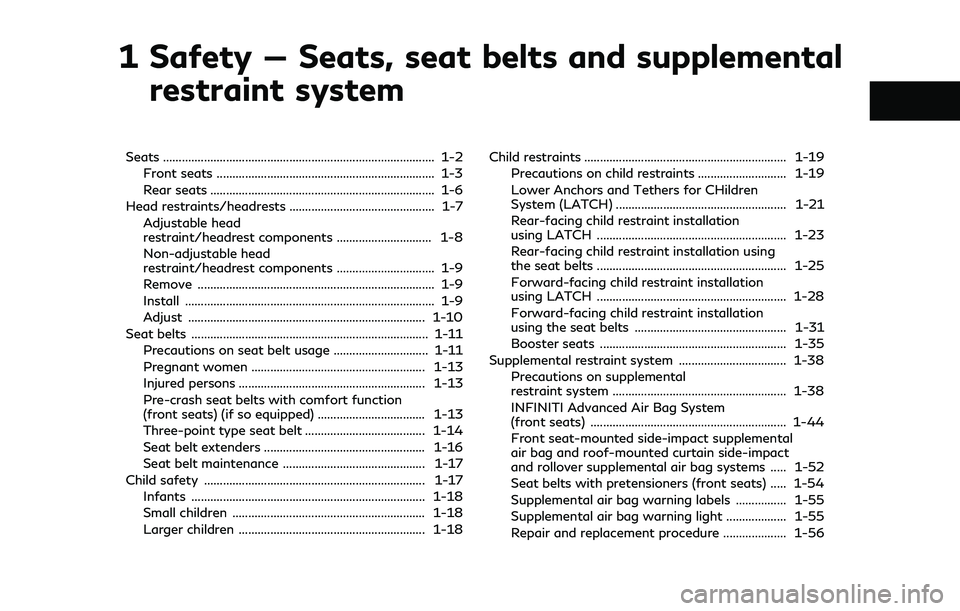
1 Safety — Seats, seat belts and supplementalrestraint system
Seats ........................................................................\
.............. 1-2
Front seats ..................................................................... 1-3
Rear seats ....................................................................... 1-6
Head restraints/headrests .............................................. 1-7 Adjustable head
restraint/headrest components .............................. 1-8
Non-adjustable head
restraint/headrest components ............................... 1-9
Remove ........................................................................\
... 1-9
Install ........................................................................\
....... 1-9
Adjust ........................................................................\
... 1-10
Seat belts ........................................................................\
... 1-11 Precautions on seat belt usage .............................. 1-11
Pregnant women ....................................................... 1-13
Injured persons ........................................................... 1-13
Pre-crash seat belts with comfort function
(front seats) (if so equipped) .................................. 1-13
Three-point type seat belt ...................................... 1-14
Seat belt extenders ................................................... 1-16
Seat belt maintenance ............................................. 1-17
Child safety ...................................................................... 1-17 Infants ........................................................................\
.. 1-18
Small children ............................................................. 1-18
Larger children ........................................................... 1-18 Child restraints ................................................................ 1-19
Precautions on child restraints ............................ 1-19
Lower Anchors and Tethers for CHildren
System (LATCH) ...................................................... 1-21
Rear-facing child restraint installation
using LATCH ............................................................ 1-23
Rear-facing child restraint installation using
the seat belts ............................................................ 1-25
Forward-facing child restraint installation
using LATCH ............................................................ 1-28
Forward-facing child restraint installation
using the seat belts ................................................ 1-31
Booster seats ........................................................... 1-35
Supplemental restraint system .................................. 1-38 Precautions on supplemental
restraint system ....................................................... 1-38
INFINITI Advanced Air Bag System
(front seats) .............................................................. 1-44
Front seat-mounted side-impact supplemental
air bag and roof-mounted curtain side-impact
and rollover supplemental air bag systems ..... 1-52
Seat belts with pretensioners (front seats) ..... 1-54
Supplemental air bag warning labels ................ 1-55
Supplemental air bag warning light ................... 1-55
Repair and replacement procedure .................... 1-56
Page 27 of 476
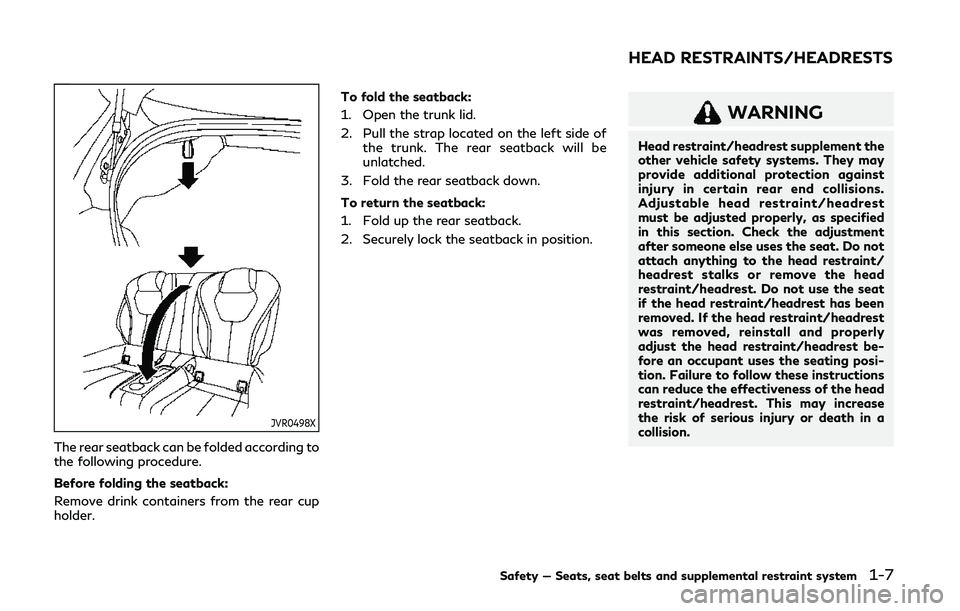
JVR0498X
The rear seatback can be folded according to
the following procedure.
Before folding the seatback:
Remove drink containers from the rear cup
holder.To fold the seatback:
1. Open the trunk lid.
2. Pull the strap located on the left side of
the trunk. The rear seatback will be
unlatched.
3. Fold the rear seatback down.
To return the seatback:
1. Fold up the rear seatback.
2. Securely lock the seatback in position.
WARNING
Head restraint/headrest supplement the
other vehicle safety systems. They may
provide additional protection against
injury in certain rear end collisions.
Adjustable head restraint/headrest
must be adjusted properly, as specified
in this section. Check the adjustment
after someone else uses the seat. Do not
attach anything to the head restraint/
headrest stalks or remove the head
restraint/headrest. Do not use the seat
if the head restraint/headrest has been
removed. If the head restraint/headrest
was removed, reinstall and properly
adjust the head restraint/headrest be-
fore an occupant uses the seating posi-
tion. Failure to follow these instructions
can reduce the effectiveness of the head
restraint/headrest. This may increase
the risk of serious injury or death in a
collision.
Safety — Seats, seat belts and supplemental restraint system1-7
HEAD RESTRAINTS/HEADRESTS
Page 28 of 476
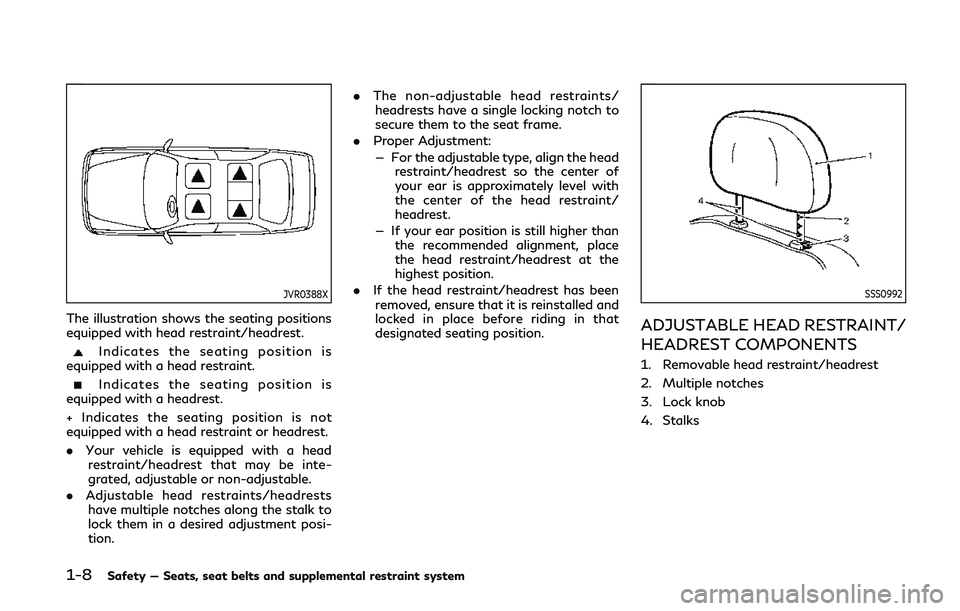
1-8Safety — Seats, seat belts and supplemental restraint system
JVR0388X
The illustration shows the seating positions
equipped with head restraint/headrest.
Indicates the seating position is
equipped with a head restraint.
Indicates the seating position is
equipped with a headrest.
+ Indicates the seating position is not
equipped with a head restraint or headrest.
. Your vehicle is equipped with a head
restraint/headrest that may be inte-
grated, adjustable or non-adjustable.
. Adjustable head restraints/headrests
have multiple notches along the stalk to
lock them in a desired adjustment posi-
tion. .
The non-adjustable head restraints/
headrests have a single locking notch to
secure them to the seat frame.
. Proper Adjustment:
— For the adjustable type, align the head restraint/headrest so the center of
your ear is approximately level with
the center of the head restraint/
headrest.
— If your ear position is still higher than the recommended alignment, place
the head restraint/headrest at the
highest position.
. If the head restraint/headrest has been
removed, ensure that it is reinstalled and
locked in place before riding in that
designated seating position.
SSS0992
ADJUSTABLE HEAD RESTRAINT/
HEADREST COMPONENTS
1. Removable head restraint/headrest
2. Multiple notches
3. Lock knob
4. Stalks
Page 29 of 476
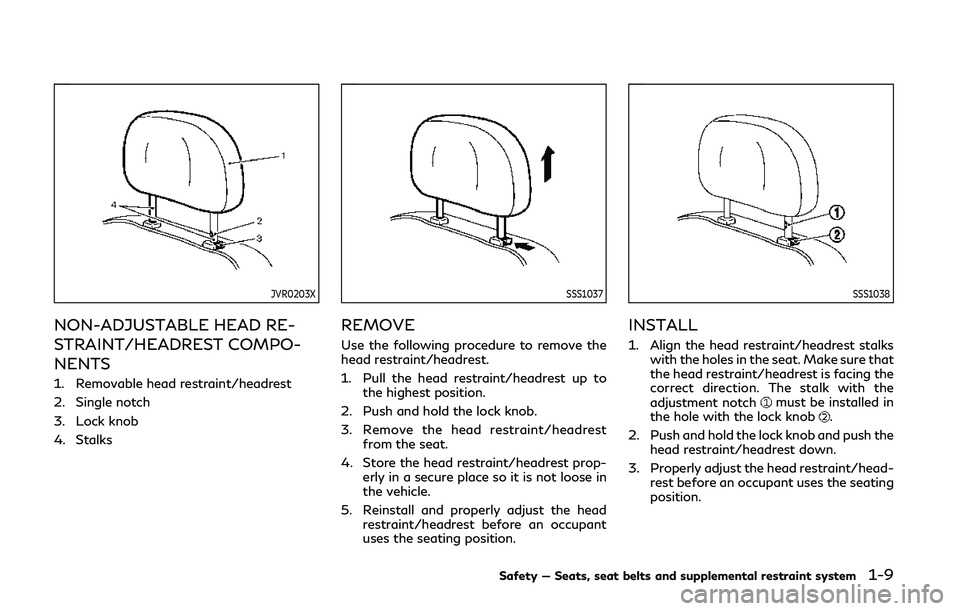
JVR0203X
NON-ADJUSTABLE HEAD RE-
STRAINT/HEADREST COMPO-
NENTS
1. Removable head restraint/headrest
2. Single notch
3. Lock knob
4. Stalks
SSS1037
REMOVE
Use the following procedure to remove the
head restraint/headrest.
1. Pull the head restraint/headrest up tothe highest position.
2. Push and hold the lock knob.
3. Remove the head restraint/headrest from the seat.
4. Store the head restraint/headrest prop- erly in a secure place so it is not loose in
the vehicle.
5. Reinstall and properly adjust the head restraint/headrest before an occupant
uses the seating position.
SSS1038
INSTALL
1. Align the head restraint/headrest stalks
with the holes in the seat. Make sure that
the head restraint/headrest is facing the
correct direction. The stalk with the
adjustment notch
must be installed in
the hole with the lock knob.
2. Push and hold the lock knob and push the head restraint/headrest down.
3. Properly adjust the head restraint/head- rest before an occupant uses the seating
position.
Safety — Seats, seat belts and supplemental restraint system1-9
Page 30 of 476
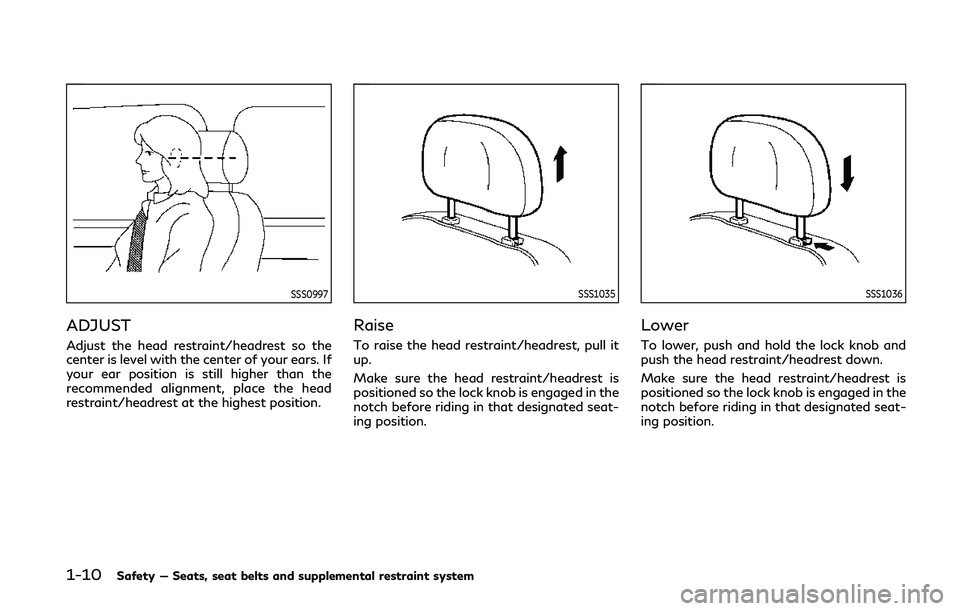
1-10Safety — Seats, seat belts and supplemental restraint system
SSS0997
ADJUST
Adjust the head restraint/headrest so the
center is level with the center of your ears. If
your ear position is still higher than the
recommended alignment, place the head
restraint/headrest at the highest position.
SSS1035
Raise
To raise the head restraint/headrest, pull it
up.
Make sure the head restraint/headrest is
positioned so the lock knob is engaged in the
notch before riding in that designated seat-
ing position.
SSS1036
Lower
To lower, push and hold the lock knob and
push the head restraint/headrest down.
Make sure the head restraint/headrest is
positioned so the lock knob is engaged in the
notch before riding in that designated seat-
ing position.
Page 38 of 476
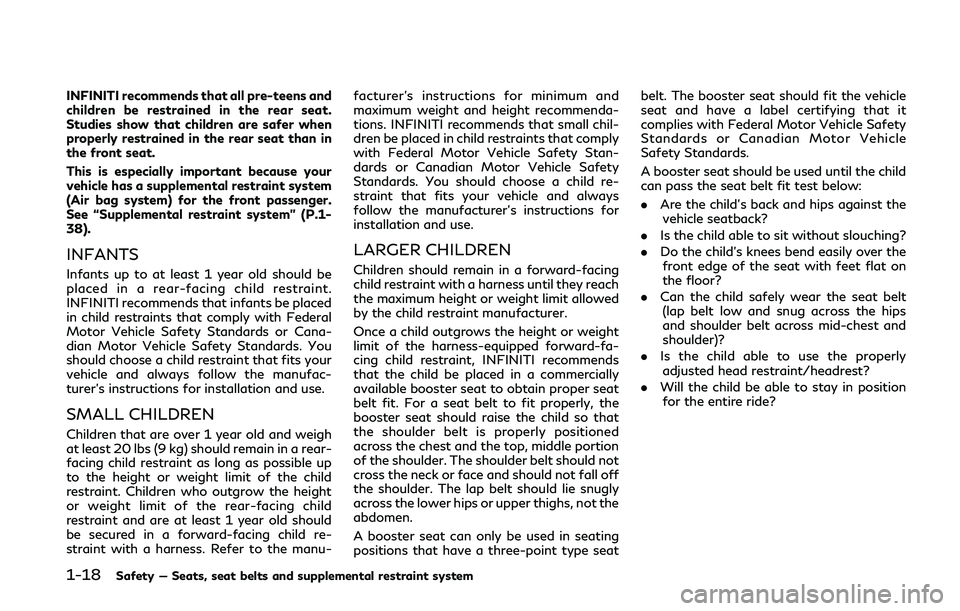
1-18Safety — Seats, seat belts and supplemental restraint system
INFINITI recommends that all pre-teens and
children be restrained in the rear seat.
Studies show that children are safer when
properly restrained in the rear seat than in
the front seat.
This is especially important because your
vehicle has a supplemental restraint system
(Air bag system) for the front passenger.
See “Supplemental restraint system” (P.1-
38).
INFANTS
Infants up to at least 1 year old should be
placed in a rear-facing child restraint.
INFINITI recommends that infants be placed
in child restraints that comply with Federal
Motor Vehicle Safety Standards or Cana-
dian Motor Vehicle Safety Standards. You
should choose a child restraint that fits your
vehicle and always follow the manufac-
turer’s instructions for installation and use.
SMALL CHILDREN
Children that are over 1 year old and weigh
at least 20 lbs (9 kg) should remain in a rear-
facing child restraint as long as possible up
to the height or weight limit of the child
restraint. Children who outgrow the height
or weight limit of the rear-facing child
restraint and are at least 1 year old should
be secured in a forward-facing child re-
straint with a harness. Refer to the manu-facturer’s instructions for minimum and
maximum weight and height recommenda-
tions. INFINITI recommends that small chil-
dren be placed in child restraints that comply
with Federal Motor Vehicle Safety Stan-
dards or Canadian Motor Vehicle Safety
Standards. You should choose a child re-
straint that fits your vehicle and always
follow the manufacturer’s instructions for
installation and use.
LARGER CHILDREN
Children should remain in a forward-facing
child restraint with a harness until they reach
the maximum height or weight limit allowed
by the child restraint manufacturer.
Once a child outgrows the height or weight
limit of the harness-equipped forward-fa-
cing child restraint, INFINITI recommends
that the child be placed in a commercially
available booster seat to obtain proper seat
belt fit. For a seat belt to fit properly, the
booster seat should raise the child so that
the shoulder belt is properly positioned
across the chest and the top, middle portion
of the shoulder. The shoulder belt should not
cross the neck or face and should not fall off
the shoulder. The lap belt should lie snugly
across the lower hips or upper thighs, not the
abdomen.
A booster seat can only be used in seating
positions that have a three-point type seatbelt. The booster seat should fit the vehicle
seat and have a label certifying that it
complies with Federal Motor Vehicle Safety
Standards or Canadian Motor Vehicle
Safety Standards.
A booster seat should be used until the child
can pass the seat belt fit test below:
.
Are the child’s back and hips against the
vehicle seatback?
. Is the child able to sit without slouching?
. Do the child’s knees bend easily over the
front edge of the seat with feet flat on
the floor?
. Can the child safely wear the seat belt
(lap belt low and snug across the hips
and shoulder belt across mid-chest and
shoulder)?
. Is the child able to use the properly
adjusted head restraint/headrest?
. Will the child be able to stay in position
for the entire ride?
Page 52 of 476
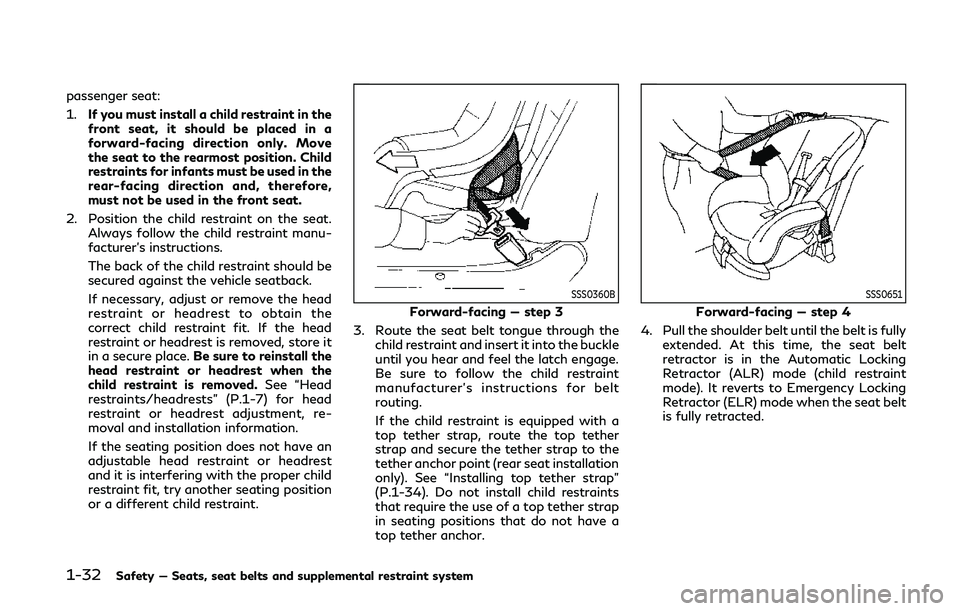
1-32Safety — Seats, seat belts and supplemental restraint system
passenger seat:
1.If you must install a child restraint in the
front seat, it should be placed in a
forward-facing direction only. Move
the seat to the rearmost position. Child
restraints for infants must be used in the
rear-facing direction and, therefore,
must not be used in the front seat.
2. Position the child restraint on the seat. Always follow the child restraint manu-
facturer’s instructions.
The back of the child restraint should be
secured against the vehicle seatback.
If necessary, adjust or remove the head
restraint or headrest to obtain the
correct child restraint fit. If the head
restraint or headrest is removed, store it
in a secure place. Be sure to reinstall the
head restraint or headrest when the
child restraint is removed. See “Head
restraints/headrests” (P.1-7) for head
restraint or headrest adjustment, re-
moval and installation information.
If the seating position does not have an
adjustable head restraint or headrest
and it is interfering with the proper child
restraint fit, try another seating position
or a different child restraint.
SSS0360B
Forward-facing — step 3
3. Route the seat belt tongue through the child restraint and insert it into the buckle
until you hear and feel the latch engage.
Be sure to follow the child restraint
manufacturer’s instructions for belt
routing.
If the child restraint is equipped with a
top tether strap, route the top tether
strap and secure the tether strap to the
tether anchor point (rear seat installation
only). See “Installing top tether strap”
(P.1-34). Do not install child restraints
that require the use of a top tether strap
in seating positions that do not have a
top tether anchor.
SSS0651
Forward-facing — step 4
4. Pull the shoulder belt until the belt is fully extended. At this time, the seat belt
retractor is in the Automatic Locking
Retractor (ALR) mode (child restraint
mode). It reverts to Emergency Locking
Retractor (ELR) mode when the seat belt
is fully retracted.
Page 57 of 476
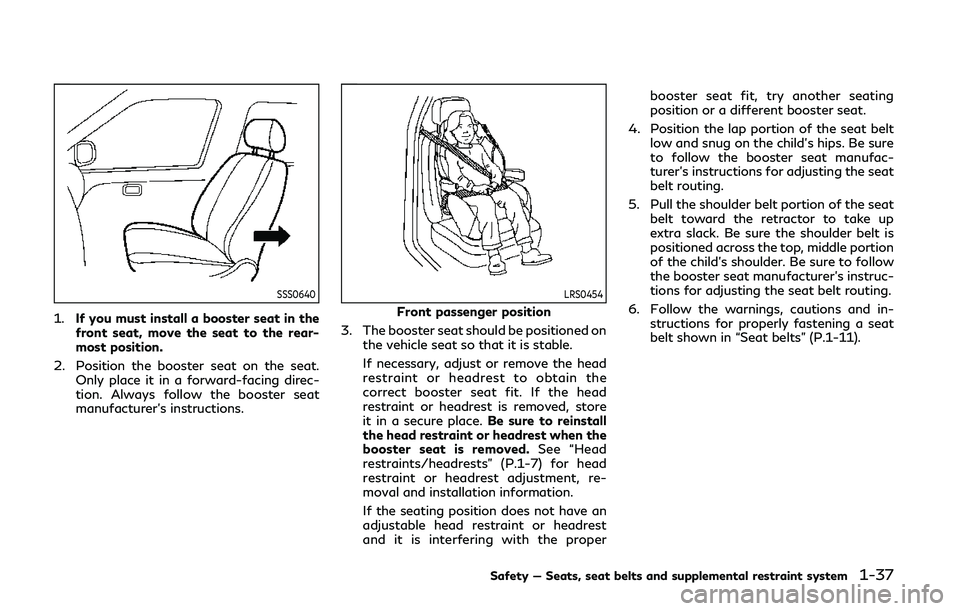
SSS0640
1.If you must install a booster seat in the
front seat, move the seat to the rear-
most position.
2. Position the booster seat on the seat. Only place it in a forward-facing direc-
tion. Always follow the booster seat
manufacturer’s instructions.
LRS0454
Front passenger position
3. The booster seat should be positioned on the vehicle seat so that it is stable.
If necessary, adjust or remove the head
restraint or headrest to obtain the
correct booster seat fit. If the head
restraint or headrest is removed, store
it in a secure place. Be sure to reinstall
the head restraint or headrest when the
booster seat is removed. See “Head
restraints/headrests” (P.1-7) for head
restraint or headrest adjustment, re-
moval and installation information.
If the seating position does not have an
adjustable head restraint or headrest
and it is interfering with the proper booster seat fit, try another seating
position or a different booster seat.
4. Position the lap portion of the seat belt low and snug on the child’s hips. Be sure
to follow the booster seat manufac-
turer’s instructions for adjusting the seat
belt routing.
5. Pull the shoulder belt portion of the seat belt toward the retractor to take up
extra slack. Be sure the shoulder belt is
positioned across the top, middle portion
of the child’s shoulder. Be sure to follow
the booster seat manufacturer’s instruc-
tions for adjusting the seat belt routing.
6. Follow the warnings, cautions and in- structions for properly fastening a seat
belt shown in “Seat belts” (P.1-11).
Safety — Seats, seat belts and supplemental restraint system1-37
Page 463 of 476
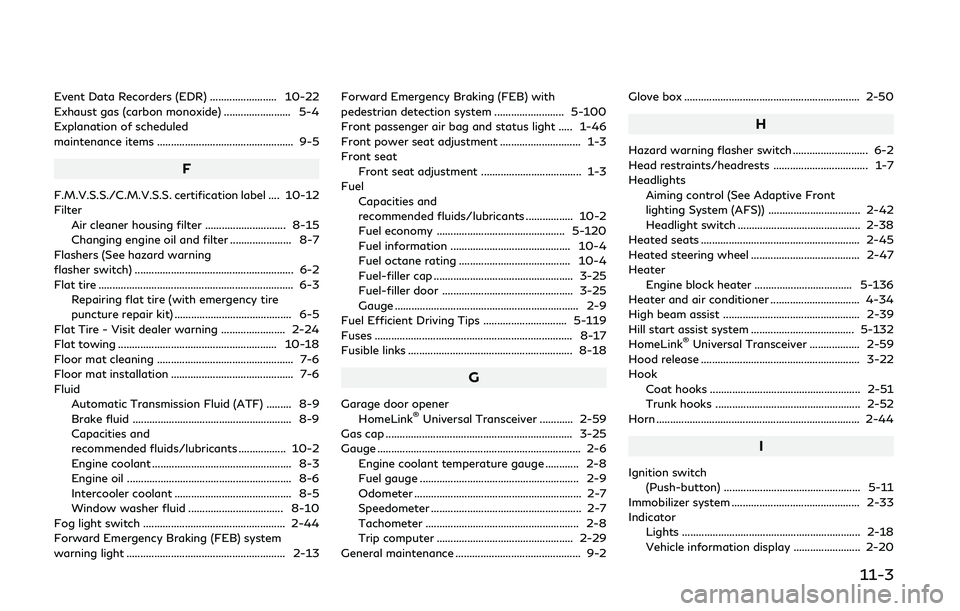
Event Data Recorders (EDR) ........................ 10-22
Exhaust gas (carbon monoxide) ........................ 5-4
Explanation of scheduled
maintenance items ................................................. 9-5
F
F.M.V.S.S./C.M.V.S.S. certification label .... 10-12
FilterAir cleaner housing filter ............................. 8-15
Changing engine oil and filter ...................... 8-7
Flashers (See hazard warning
flasher switch) ......................................................... 6-2
Flat tire ...................................................................... 6-3 Repairing flat tire (with emergency tire
puncture repair kit) .......................................... 6-5
Flat Tire - Visit dealer warning ....................... 2-24
Flat towing ......................................................... 10-18
Floor mat cleaning ................................................. 7-6
Floor mat installation ............................................ 7-6
Fluid Automatic Transmission Fluid (ATF) ......... 8-9
Brake fluid ......................................................... 8-9
Capacities and
recommended fluids/lubricants ................. 10-2
Engine coolant .................................................. 8-3
Engine oil ........................................................... 8-6
Intercooler coolant .......................................... 8-5
Window washer fluid .................................. 8-10
Fog light switch ................................................... 2-44
Forward Emergency Braking (FEB) system
warning light ......................................................... 2-13 Forward Emergency Braking (FEB) with
pedestrian detection system ......................... 5-100
Front passenger air bag and status light ..... 1-46
Front power seat adjustment ............................. 1-3
Front seat
Front seat adjustment .................................... 1-3
Fuel
Capacities and
recommended fluids/lubricants ................. 10-2
Fuel economy .............................................. 5-120
Fuel information ........................................... 10-4
Fuel octane rating ........................................ 10-4
Fuel-filler cap .................................................. 3-25
Fuel-filler door ............................................... 3-25
Gauge .................................................................. 2-9
Fuel Efficient Driving Tips .............................. 5-119
Fuses ....................................................................... 8-17
Fusible links ........................................................... 8-18
G
Garage door opener
HomeLink®Universal Transceiver ............ 2-59
Gas cap ................................................................... 3-25
Gauge ........................................................................\
. 2-6
Engine coolant temperature gauge ............ 2-8
Fuel gauge ......................................................... 2-9
Odometer ............................................................ 2-7
Speedometer ...................................................... 2-7
Tachometer ....................................................... 2-8
Trip computer ................................................. 2-29
General maintenance ............................................. 9-2 Glove box ............................................................... 2-50
H
Hazard warning flasher switch ........................... 6-2
Head restraints/headrests .................................. 1-7
Headlights
Aiming control (See Adaptive Front
lighting System (AFS)) ................................. 2-42
Headlight switch ............................................ 2-38
Heated seats ......................................................... 2-45
Heated steering wheel ....................................... 2-47
Heater Engine block heater ................................... 5-136
Heater and air conditioner ................................ 4-34
High beam assist ................................................. 2-39
Hill start assist system ..................................... 5-132
HomeLink
®Universal Transceiver .................. 2-59
Hood release ......................................................... 3-22
Hook Coat hooks ...................................................... 2-51
Trunk hooks .................................................... 2-52
Horn ........................................................................\
. 2-44
I
Ignition switch (Push-button) ................................................. 5-11
Immobilizer system .............................................. 2-33
Indicator Lights ................................................................ 2-18
Vehicle information display ........................ 2-20
11-3